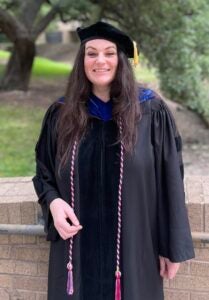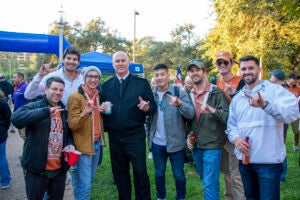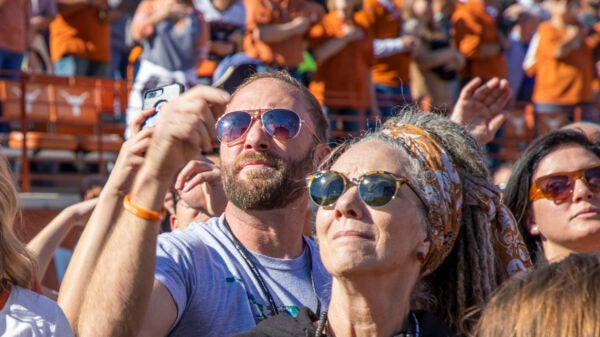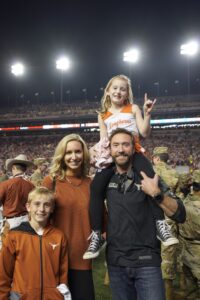“The military takes a very long time training you how to be a soldier, and a couple of weeks training you how to be a civilian again,” Jeremiah Gunderson says.
He should know, because before he came to The University of Texas at Austin to lead what is now its office of Veteran and Military Affiliated Services (VMAS), he oversaw the team doing the Department of Veterans Affairs portion of that transition training at Fort Cavazos (then Fort Hood) near Killeen. And before that, he experienced the challenges firsthand when he got out of the service in 2009 and enrolled at Central Texas College as a student veteran. “I saw how difficult it was.”
Today, UT Austin is the No. 1 university in Texas for student veterans and quickly has become one of the top in the nation. The reasons are many, but the people behind the work are the three employees who run the “small but mighty” office: Gunderson, David Lessenberry and Michael Knox.
These rankings represent a turnaround in perception. The stereotype of Austin and the University as leaning liberal and therefore anti-military was a stigma the staff had to fight. “It’s obviously not true,” Gunderson says. “We sought to change that narrative, to fix that, and I think we have. Austin and the University have been incredibly welcoming and inclusive for our military, veterans and their families.”
A Short History of Student Veteran Services
The concept of offices on college campuses dedicated to student veterans is relatively new and emerged when universities saw a huge influx of service members coming home from wars in Afghanistan and Iraq. “There was this massive group that started going to college and using these newfangled benefits that nobody knew how to handle,” Gunderson says. The Post-9/11 GI Bill, enacted in 2009, was the impetus for many of these offices.
UT’s leaders identified the need quickly but didn’t know what the services should look like, so they built the proverbial plane while flying it. What’s more, other universities are still looking to UT for how to structure their own services. “I’ve received calls from all over the country from universities trying to stand up offices like this,” he says. Indeed, colleagues from Florida have just visited to learn how UT’s program works.
In 2011, UT opened the office of Student Veterans Services, led by Ben Armstrong. “He was the sledgehammer — he opened a lot of doors,” Gunderson says. “I’m more the scalpel, to navigate the politics and build on the foundation he created.”
Gunderson knows scalpels, having served as an Army medic during the bloodiest period of the Iraq War, an experience that gives him deep empathy for the student veterans he works with. “It was an incredible experience I never ever want to have again.”
Take those skills you have, the things you learned, the things you're good at, and leave all that other stuff behind..."
In 2021, the name of the office was changed to reflect the group’s expanded mission: Veteran and Military Affiliated Services. UT has about 520 student veterans, but it also has active duty, National Guard, Reserves from all of the branches, and Texas State Guard. Additionally, about 1,500 dependents of veterans are Longhorn students. Now, as the convener of the new Military and Veteran Stakeholder Council, VMAS coordinates with 22 different offices that deal with military affairs. Those include the President’s Office, the Office of Defense Research Advancement, which brought in millions in military contracts to the University last year alone, the Institute for Veteran Family Wellness, which also helps coordinate the annual Military Social Work Conference on the Forty Acres, and the Austin-headquartered Army Futures Command.
What Vets Need and Don’t Need
First and foremost, veterans need help with the bureaucracy, because if they fail to get into UT, nothing else matters. “There are a lot of uniquely weird difficulties that veterans face, like not being able to take prerequisites because the GI Bill won’t pay for them” says Rebecca Larson, an Air Force veteran who just graduated with her fourth degree from UT. “There needed to be some training about how the GI Bill is different from just a normal person going through school. So Jeremiah and the VMAS office implemented an adviser training so academic advisers could learn what the GI Bill requirements are.” VMAS also implemented a mentor program, so from the moment a veteran applies, a mentor helps them through the whole process.
Once at UT, veterans need community. “Community is important everywhere,” Gunderson says, “but there’s no stronger fraternity than the military. You put on a uniform, you’re out there, and people’s lives are in your hands and yours is in their hands. And then somebody stamps a paper on your last day, and it’s ‘Good luck!’ and you just lose that sense of community. Our veterans make up less than 1% of the whole campus. It can feel really isolating. There’s a lot of impostor syndrome. They’re not quite like faculty, but they’re not quite students.” He says many of them associate more with their teaching assistants than their fellow students. “What I think community does more than anything is to normalize people’s experience.”
To help build that community there are events such as tailgates, welcome-back barbecues and graduation events. Larson says Gunderson has been “phenomenal” at finding donors to fund these.
But the community that vets need is not the type of community they might be used to, what Larson and Gunderson both identify as “bro culture.”

When Larson arrived as an undergraduate in 2013, she found male student veterans were more interested in hitting on their female counterparts than creating actual community with them. One afternoon shortly after coming to UT, Gunderson met at the Crown & Anchor Pub with Larson and other members of a UT women veterans group. He remembers, “I proceeded to get chewed out for two hours about what a disaster it was, because there is an ultramasculine, sometimes misogynistic, mindset in the military with some males, and it had become a little bit of that in the office.”
“A lot of women leave the military to get away from that,” Larson says, only to discover that culture followed them to their new college experience.
“It was a turning point for me,” Gunderson says, “and I wanted to create an inclusive culture that responded to the needs of everybody. It’s an opportunity to build that community, but this isn’t a bro vet culture either. You’re not in the military anymore. You don’t treat people like that. You don’t talk like that. Don’t expect to be treated like that. We understand the importance of community and lifting each other up and challenging each other to be better as veterans.”
Judging by the numbers at events, something seems to be working. When Gunderson and Larson started the football game tailgates — one for the home opener and one for the military veterans game — Gunderson recalls it was “20 bro vets sitting around a keg over at Dean Keeton and San Jac.” Last year, the tailgate had 550 people, including the vice chairman of the Joint Chiefs of Staff, and was fully funded by outside donors. It has become such a massive operation that this year they are hiring professionals to run it.
![_ROY1510 copy[51]](https://news.utexas.edu/wp-content/uploads/2023/07/ROY1510-copy51-e1689275098600-300x200-c-default.jpg)

The Existential Questions
It’s hard to overstate the jolt many veterans feel upon entering college.
One Longhorn student led a platoon of Marines as a staff sergeant in Fallujah, Iraq. Weeks later he was “sitting here on campus with a backpack on,” Gunderson says.
Likewise, the VMAS Veteran Advisor and Gunderson’s right-hand, David Lessenberry, was a Navy senior chief running part of the U.S. Embassy in Paris and a few weeks later was at UT, an undergraduate in his late 40s. Such loss of authority and shifts in “tasks of significance,” as Gunderson calls them, are jarring to say the least. “All kinds of data show that the first year people get out is make or break,” he adds.
“People ask me what the No. 1 issue student veterans face is. It’s not benefits; we can sort all that out. It’s existential questions,” Gunderson says. “It’s ‘What am I doing here? I’m 35 years old. I’m on a college campus with a bunch of kids. I don’t know what I’m going to do with this when I’m done.’” When vets are in that frame of mind, and then hit academic issues common to nearly all students, many want to give up.
The military is a culture of rules, and the VMAS office has implemented its own philosophical rules to give veterans their best chance at successfully reintegrating into society.
The first is that vets should not minimize the military experience of others. “It doesn’t matter if somebody sat on a base and never went anywhere, because I can tell you if you sat on our base [in Iraq] in 2003, you couldn’t walk across the street, you couldn’t go outside to get something without risking getting hit by a mortar round or sniper fire. There are no weekends. There’s no driving to the store. There’s no going out to the bar with your friends. You work Monday through Sunday, 13, 18 hours a day, whatever the mission calls for, without breaks, without downtime. That takes a toll on anyone.”
Also, vets should not minimize the experiences of traditional students or look down on them. Student veterans’ average age is 29, and many are first-generation college students. “We want our veterans to understand that, yes, you have had all these amazing experiences, but this 18-year-old — you can’t minimize their experience and how they got here. We have this joke at orientation: They’ve forgotten more about chemistry than you know, so you should probably befriend them! Take your leadership, tasks of significance, experience and knowledge and, maybe instead of just looking down on your fellow students because they don’t have that, try to mentor them and learn from them as a way to integrate back. Because you’re going to be working with them eventually, and they might be your boss.
“Take those skills you have, the things you learned, the things you’re good at, and leave all that other stuff behind — the bro culture,” he says. “You can’t yell at people. You have to build relationships and network with people.” Each type of student has something valuable to offer the other.
One of the most significant challenges is to help vets without creating dependency. “I’ve always said our motto is to facilitate opportunities for veteran students to succeed. We’re not going to hand-hold. We’re not going to give you a handout. We’re not going to give anything. We help, but we never give more than the student. I think the reason there have been so many issues with many Vietnam-era veterans is because we initially screwed it up so badly as a country that we overcompensated and said, ‘Let’s just give you everything.’”
”We need to help people transition out of the military. A lot of other student veteran offices have camo netting everywhere. We try to go in a different direction and say, ‘You have all this valuable experience in the military; you’ve done things that most Americans haven’t done and seen. But now you need to leave that behind. If you go the rest of your life, you’re going to be that 60-year-old guy sitting in the VA hospital telling war stories. You’re 29!’
“Deep down, we all know that they have more to give. Let’s turn the page, start a whole new chapter in your life.”
It’s also important to Gunderson to avoid stereotyping vets as suicidal or assuming they all have post-traumatic stress disorder. Gunderson ran the suicide-prevention program at Fort Cavazos for several years so again brings deep experience. “We try to avoid getting hung up on stigmas about vets: Every vet has PTSD; they’re probably going to kill themselves. You hear that over and over again. We focus on a success-based model.”
A lot of other student veteran offices have camo netting everywhere. We try to go in a different direction ..."
Another way the VMAS supports students is financially. One especially meaningful experience Gunderson has had was when a veteran’s mother, Dayton Williams, established a scholarship to honor her son, Ty. He had served as a Marine in Iraq, and was killed by a hit-and-run driver in Austin before he could enroll at UT. The scholarship she established was for a student to attend UT in Ty’s place. “The impact when we can connect someone like Dayton with our student veterans and their families — that’s the most fulfilling thing I do here.”
The largest scholarship fund, $325,000, was established by the Jean Perkins Foundation to award $5,000 to 55 student veterans to make summer internships and research experiences possible. “I don’t know another school in the country that gives $50,000 a year in discretionary funding specifically for our veterans,” Gunderson says.
After a decade, he’s seeing the fruits of their labor. “The students who started out in our program are doing important work at companies and getting well established. We’re feeling the impact of what was given to them here, because now they’re trying to do the same thing in their community, and a lot of them come back here and give back.”

‘Austin? I think there’s a college there’
Jeremiah Gunderson grew up in western Michigan and joined the Army at 26, married with three kids. He fell in love with Texas when he moved to San Antonio for his medic training. “Everybody’s complaining about the heat; I love it. Talk to me when it’s 26 below zero and you’re shoveling snow to get out of your driveway.”
 He deployed twice to Iraq, in 2003 and 2005, serving his fellow soldiers and helping to stand up hospitals for the Iraqi people. He describes suturing patients with major trauma in the back of a vehicle with night-vision goggles. “It was an incredible experience I never ever want to have again.”
He deployed twice to Iraq, in 2003 and 2005, serving his fellow soldiers and helping to stand up hospitals for the Iraqi people. He describes suturing patients with major trauma in the back of a vehicle with night-vision goggles. “It was an incredible experience I never ever want to have again.”
Another experience he shares with many vets he works with is being a first-generation college student. He majored in political science. He chuckles. “When I graduated, I opened the paper, and started looking for political scientist. … ‘No, there aren’t any jobs.’”
He wanted to keep serving the military, “but I needed to step away from the military community,” as well as from Killeen, he says. His eyes turned to Austin. “People always ask me how I wound up at UT. ‘Have you always wanted to work there? Do you just love the Longhorns?’ When I started looking, I thought, I want to move to Austin, and I think there’s a college there.” He swears that’s a true story.
When he found UT’s job board, the planets aligned and the University happened to be hiring for the coordinator for Student Veteran Services. Gunderson never looked back and values his decade as a member of the Longhorn family, especially the opportunity the University has provided him to continue to serve his military sisters and brothers, both in and out of uniform.
Above: Gunderson with his wife, Traci Blakemore, and stepchildren Luke and Evan Miller.

![Veterans_Events_069[40] copy](https://news.utexas.edu/wp-content/uploads/2023/07/Veterans_Events_06940-copy-1-600x400-c-default.jpeg)


